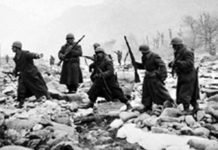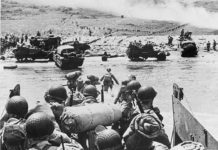When the founding fathers decided on a national defense after the Revolutionary War, they were suspicious of standing armies and preferred instead to have a small professional army backed up by a large militia drawn from the separate states. This militia system is what the US went to war with from 1791 until 1903. In 1903 the Dick Act made all state militia liable for federal service as the National Guard alongside the regular Army in the event of war. While this formed a stronger military for foreign service, it also left the new reality that the individual states could be left with no defense forces, their local troops being called up and set overseas. Thus was born the concept of the modern Home Guard.
The Home Guard
These troops were to serve the local city county and state governments during civil disturbances, insurrection, resistance to sabotage and disasters. In World War 1 some 79,000 volunteers served in states mainly on the east and gulf coast watching for U-Boats, guarding the waterfront and protecting infrastructure. In World War 2, with threats to the entire United States no less than 139,000 served in Home Guards. In 1986, when the United States Army adopted the “Total Force Concept” in which the National Guard of all states are trained as, and considered an integral part of, the active duty forces, again State Defense forces were renewed and today 22 states still maintain them.
Author Barry Stentiford, a Captain in the Army Reserve and a full time professor of history at Grambling State University, has performed an admirable task in researching the above and has produced The American Home Guard; The State Militia in the 20th Century.
Review of the American Home Guard
Using primary sources as exhibited with nearly a hundred pages of endnotes and bibliography, Stentiford extensively audits the history and organization of the State Defense Forces from 1903 through 1999. Beginning with the aftermath of the Spanish American War and moving into World War 1 the story unfolds in the evolution of home guards in the work. Particular examples are made of such minor and ineffective units such as the Alabama guard, based on a system reporting to individual county sheriffs, contrasted with large well-equipped and organized units such as those in New York.
Great attention is spent to the State Guard and Home Guards in World War 2, if fact the majority of the book focuses on this period and rightly so. Detail is paid to the Eskimo Scouts of Alaska, the Hawaiian Territorial Guard who responded to the invasion threats after Pearl Harbor, and that of many other states and territories. Finally, the Cold War period reorganization and rebirth is documented to include the Mississippi Plan from universal military training and National Service among other topics.
In closing
It is a scholarly work of no doubt, however The American Home Guard could have benefited from even a few illustrations as well as charts and graphs, none of which are present in the volume. Even with this minor omission, Professor Stentiford’s work is the best text available on a subject that has fallen through the cracks of US military history and is highly readable.








